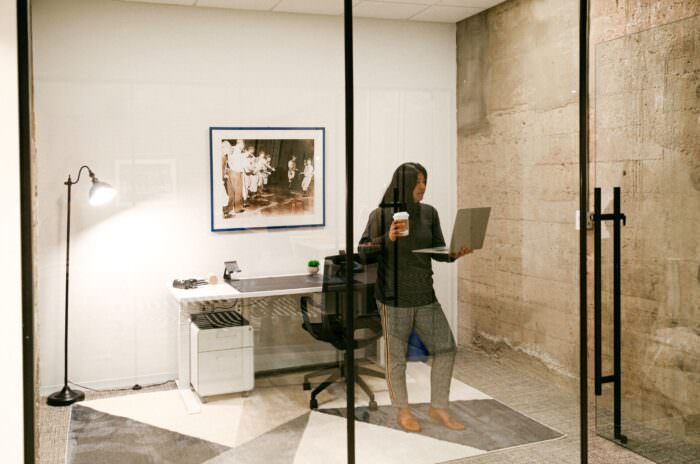As COVID-19 restrictions are eased around the United States, many companies and individuals alike have begun to explore new ways to work for an array of reasons.
If working remotely for almost a year and a half has taught us anything, it’s that the location of where work is being done isn’t necessarily negatively correlated with quality of work.
As the months wore on during the pandemic, work productivity turned into boredom, loneliness, and burnout, which in turn, has now created demand for new, innovative ways to work.
New ways that are more flexible.
New ways that are more conducive to long term work productivity.
And new ways that begin to evoke that sense of normalcy that we’ve all missed.
Where do we find a solution to this demand?
The answer is simple: the use of a shared workspace, the services it includes, and the benefits that come with it.
Follow along to learn why this work style is worthwhile for your business.
What is a Shared Workspace?
Shared workspaces – or often referred to as shared offices or coworking spaces – are ergonomic workstations on a shared floor that can be rented and utilized by the day, hour, month, or year. Shared workspaces provide ultimate flexibility when it comes to term length and location as they are amply located in many markets around the world.
While coworking spaces are sometimes thought of as seats in open areas, many shared workspace providers offer workstations or offices that are centered around privacy and the addition of amenities and services.
But the term “shared” doesn’t always translate to sharing an office with someone else or sitting in a common area with someone else.
Many companies now rent private offices or dedicated team rooms which are located on the shared floor with other businesses that are doing the same thing.
What Types of Companies Have Traditionally Worked in Shared Workspaces?
As alluded to in the name, a ‘shared workspace’, is a place to work on a shared floor with shared amenities and conference rooms.
As these spaces are usually smaller than a massive corporate office, they give businesses the ability to choose the size of the space to suit their specific needs. Thus, eliminating any potential excess space that may be underutilized over time. These workspaces have traditionally been used by the likes of:
What Types of Companies Are Considering Shared Workspaces Today?
As COVID-19 forced the immediate closing of large headquarter offices, many larger corporations have begun to delve into the world of coworking.
Shared workspace providers are now a more attractive solution for enterprise companies given the flexibility that these spaces offer.
Enterprise companies are now actively re-evaluating what their real estate footprint looks like and how they will deploy their workforce in a post-pandemic world.
While the days of 10+ year leases for a traditional brick-and-mortar office building certainly aren’t totally behind us, shared workspaces come with shorter, more flexible terms that can combat any uncertainty – which there is plenty of right now.
Enterprise companies who choose to use shared workspaces can also safely deploy remote teams to various workspaces across the country, without bearing the financial burden of signing long-term leases in multiple markets.
This has become especially beneficial for remote teams who thrive from face-to-face communication where shared workspaces offer a more cost-efficient, but just as effective alternative to going into a corporate headquarters.
Open Plan Workspace vs. Private Office: What’s the Difference?
As previously mentioned, shared workspaces are commonly thought of as fishbowl, open-plan environments, where individuals sit and work from wherever they desire.
This is a great option for on-the-go professionals who don’t require privacy for phone calls or to view secure, private documents.
However, this doesn’t work for everyone.
Some professionals simply cannot work from an open plan workspace based upon the type of work that they do.
Additionally, the impact of the coronavirus pandemic has diminished the popularity of the open-plan workspaces in exchange for the offering of private offices.
These private offices are within the shared workspace environment but are a safer, more secure, and sometimes more productive way to explore the benefits of coworking space.
What are the Benefits of Shared Workspaces?
Notable shared workspace providers seek to make their own team members an extension of your team by offering built-in administrative support that can span anywhere from helping you set up for an important meeting to getting your suit dry cleaned. This can save a significant amount of money because you are only paying for the support you need, when you need it.
Networking & Collaboration
When you work from a shared workspace you instantly receive access to a chock-full network of like-minded professionals that are all looking to take their business to the next level. Make connections, collaborate with other businesses, and who knows, maybe even make new friends along the way.
Café Areas
Shared workspaces almost always boast vibrant café areas which feature high speed WiFi, gourmet coffee, tea, filtered water, soft seating, and television. Carr Workplaces offers a café plan for only $45/month that allows individuals to drop in and work from any community café within the portfolio.
Cost Efficiency & Flexibility
Shared workspaces just make sense when it comes to the financials. In a world that is now dominated by uncertainty, having flexibility within your lease terms can be crucial to saving money. With shared workspaces, you can also now place employees at workstations around the country, for a fraction of the cost of establishing another headquarters. Building out traditional office space is expensive but renting a space within a shared workspace can save you money on startup costs and monthly costs.
How Does One Make the Most of a Shared Workspace?
Make Meaningful Connections
Shared workspace providers often aim to host events that connect and bring together the innovative communities that exist within a shared workspace. Although COVID-19 has altered the landscape and frequency of how these events have functioned in the last year and a half, these events can still provide opportunities to make both business and social connections with your fellow office neighbors.
Leverage On-Site Support
As smaller companies traditionally don’t have the budget or capacity to hire their own IT staff or administrative support staff, shared workspace providers do indeed possess this capability. As you settle into your new workspace, don’t hesitate to reach out to the likely on-site or virtual IT staff or professional admin support team – they want to act as an extension of your team.
Access a Portfolio of Nationwide Locations as Needed
Shared workspace providers often boast a portfolio of locations that are in various large and small markets alike, across the United States and sometimes even around the world. Utilizing these locations to host important client meetings, to access shortened commute times, and to just generally mix up your work week can be crucial in reaping the full benefits of a shared workspace.
To learn more about the shared workspaces and amenities that Carr Workplaces offers, click here.


